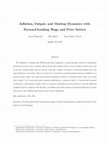Papers by Jean Gardy Victor
Social Science Research Network, Sep 1, 2015

Journal of Economic Dynamics and Control, Mar 1, 2021
Abstract We compare the cyclical and welfare implications of positive trend inflation in Taylor (... more Abstract We compare the cyclical and welfare implications of positive trend inflation in Taylor (1980) and Calvo (1983) nominal contracting models. Taylor contracts better match the correlations between nominal real variables. They generate persistent and hump-shaped responses of inflation to monetary policy and investment shocks without indexation, while Calvo contracts do not. Trend inflation has significant distorting effects on the shock impulse responses of key variables with Calvo contracts, but not with Taylor contracts. The correlation between price dispersion and trend inflation is weaker with Taylor contracts. With Calvo contracts, wage dispersion and inflation costs are very sensitive to positive trend inflation under plausible variations in the average age of wage contracts, the elasticity of substitution between skills, economic growth, and labor supply elasticity. They are much more stable with Taylor contracts. Still, based on Taylor contracts, the consumer-equivalent welfare gains resulting from a lower inflation trend after 1982 may range from 3.1% to 7.5%.
Journal of Money, Credit and Banking, Dec 25, 2018
We show that the Calvo price-setting model is not necessarily inconsistent with evidence of a wea... more We show that the Calvo price-setting model is not necessarily inconsistent with evidence of a weak relation between positive trend inflation and price dispersion. We identify the interaction between sticky wages and technical change as factors disrupting the allocative role of the wage system under positive trend inflation. In turn, this interaction generates inefficient wage dispersion, as opposed to price dispersion, which fuels inflation costs. We conclude that it is too early to dismiss the New Keynesian model as a useful vehicle to assess the costs of inflation.

European Economic Review, Jun 1, 2018
Medium-scale New Keynesian models are sometimes criticized for their use of backward-looking wage... more Medium-scale New Keynesian models are sometimes criticized for their use of backward-looking wage and price setting mechanisms, and for assuming several types of disturbances, including some that would be difficult to interpret economically. We propose a DSGE model with purely forward-looking wage and price setters and parsimoniously chosen disturbances. Our model emphasizes an interplay between production firms networking and working capital. Firms can use working capital to finance all (or a fraction) of their outlays on production factors, and use the output of other firms as an input in a what is often called a "roundabout" production structure. Our model generates a response of inflation which is mute on impact of a monetary policy shock, but highly persistent and very hump-shaped afterwards. It also yields a large contract multiplier for output, two times larger than the one implied by a model relying on indexation only. We also show that the response of the price markup can be positive on impact of an expansionary monetary policy shock, which differs from the standard countercyclical markup channel emphasized in conventional New Keynesian models. In contrast to models relying on indexation to past inflation, our model produces non-inertial responses of inflation to productivity and investment shocks, a finding which is broadly consistent with the existing VAR evidence.
Journal of Monetary Economics, Oct 1, 2020
Indeterminacy in new Keynesian models with Calvo-contracts can occur even at low trend inflation ... more Indeterminacy in new Keynesian models with Calvo-contracts can occur even at low trend inflation levels of 2 or 3%. The interaction of trend inflation with nominal wage rigidity and trend growth in output causes large distortions in the steady state and expands the indeterminacy region. Consequently, even interest rate rules with strong inflation responses may not be su cient to ensure determinacy. A policy rule reacting to output growth but not to output gap significantly increases the prospect of determinacy. Although the threat of indeterminacy is less severe under Taylorcontracts, significant departures from the original Taylor principle are required for determinacy.
RePEc: Research Papers in Economics, Feb 19, 2021
We estimate a multi-shock DSGE model with a Bayesian method allowing for determinacy or indetermi... more We estimate a multi-shock DSGE model with a Bayesian method allowing for determinacy or indeterminacy (Bianchi and Nicoló, 2020). Contrary to conventional wisdom, determinacy is preferred to indeterminacy before and after 1980. The post-1984 contribution of shocks to the marginal efficiency of investment to the cyclical variance of output growth fell dramatically, from 50% to 20%. Greater nominal wage flexibility drove the large decline in output and employment fluctuations after 1984. Inflation variability declined from a hawkish policy stance against inflation and changes in preference parameters. Lower trend inflation and smaller shocks did not play a key role.
Este ensaio tem por objetivo discutir o Mercosul como uma alternativa de integração no Cone Sul. ... more Este ensaio tem por objetivo discutir o Mercosul como uma alternativa de integração no Cone Sul. A hipótese sustentada é que as teorias de integração econômica desenvolvidas na década de 50 são insuficientes para explicar as experiências recentes de integração, isto porque, elas tratam essencialmente da integração comercial, que hoje é apenas um aspecto dos processos de regionalização. A essência das experiências recentes é, diferentemente, a criação de um espaço econômico unificado, que, ao mesmo tempo, crie estímulos para o desenvolvimento de empresas nacionais competitivas internacionalmente, mas também atraia investimentos que representem posicionamento das grandes corporações transnacionais na concorrência global. Este trabalho sustenta, ainda, que o Mercosul conseguiu sucessos significativos na integração comercial entre seus membros, mas passa, no momento.
Journal of Money, Credit and Banking, 2018
We show that the Calvo price-setting model is not necessarily inconsistent with evidence of a wea... more We show that the Calvo price-setting model is not necessarily inconsistent with evidence of a weak relation between positive trend inflation and price dispersion. We identify the interaction between sticky wages and technical change as factors disrupting the allocative role of the wage system under positive trend inflation. In turn, this interaction generates inefficient wage dispersion, as opposed to price dispersion, which fuels inflation costs. We conclude that it is too early to dismiss the New Keynesian model as a useful vehicle to assess the costs of inflation.
Journal of Monetary Economics, 2019

We offer a tale of two major postwar business cycle episodes: the pre-1980s and the post-1982s pr... more We offer a tale of two major postwar business cycle episodes: the pre-1980s and the post-1982s prior to the Great Recession. We revisit the sources of business cycles and the reasons for the large variations in aggregate volatility from the first to the second episode. Using a medium-scale DSGE model where monetary policy potentially has cost-channel effects, we first show the Fed most likely targeted deviations of output growth from trend growth, not the output gap, for measure of economic activity. When estimating our model with a policy rule reacting to output growth with Bayesian techniques, we find the US economy was not in a state of indeterminacy in either of the two sub-periods. Thus, aggregate instability before 1980 did not result from self-fulfilling changes in inflation expectations. Our evidence shows the Fed reacted more strongly to inflation after 1982. Based on sub-period estimates, we find that shocks to the marginal efficiency of investment largely drove the cyclic...

Cette these est composee de trois chapitres mettant en evidence certains mecanismes qui contribue... more Cette these est composee de trois chapitres mettant en evidence certains mecanismes qui contribuent a ameliorer l'utilite des modeles neokeynesiens pour l'analyse de politiques economiques et pour l'evaluation des couts de l'inflation. Le premier chapitre montre qu'un modele neokeynesien avec des rigidites de prix a la Calvo n'est pas necessairement en contradiction avec des evidences d'une faible correlation entre la hausse de l'inflation et la dispersion des prix et ce, meme pour des niveaux d'inflation proches de ceux des annees 1970 et du debut des annees 1980. Par consequent, comme le suggere Nakamura et al. (2017), il est peu probable que la dispersion des prix soit un facteur determinant des couts de l'inflation. Nous identifions ensuite les salaires rigides et les changements technologiques provenant du progres technique neutre et des technologies specifiques a l'investissement comme des facteurs qui alterent le role allocatif des ...

Is unconventional monetary policy stabilizing? With the Great Recession and the advent of COVID-1... more Is unconventional monetary policy stabilizing? With the Great Recession and the advent of COVID-19, this is a question macroeconomists should urgently answer. We estimate a medium-sized New Keynesian model using Bayesian techniques over a sample of data that spans from 1983:Q1 to 2019:Q4. Our focus is on the Great Recession and the recovery years. We distinguish between periods of con- ventional and unconventional monetary policy using the shadow rate of Wu and Xia (2016). We offer four main sets of substantive results. First, conditioned on monetary policy shocks, output and consumption constantly rise between 2008:Q1 and 2015:Q4, and quite significantly so, while hours worked modestly exceed their pre-recession level, and investment is mildly below its pre-2008 level. Second, conditioned on adverse and monetary policy shocks, the maximum declines in output, consumption, investment and hours are significantly smaller and occur sooner than conditioned on adverse shocks only. The eff...
We estimate a multi-shock DSGE model with a Bayesian method allowing for determinacy or indetermi... more We estimate a multi-shock DSGE model with a Bayesian method allowing for determinacy or indeterminacy (Bianchi and Nicoló, 2020). Contrary to conventional wisdom, determinacy is preferred to indeterminacy before and after 1980. The post-1984 contribution of shocks to the marginal efficiency of investment to the cyclical variance of output growth fell dramatically, from 50% to 20%. Greater nominal wage flexibility drove the large decline in output and employment fluctuations after 1984. Inflation variability declined from a hawkish policy stance against inflation and changes in preference parameters. Lower trend inflation and smaller shocks did not play a key role. JEL classification: E31, E32, E37.
Journal of Economic Dynamics and Control

We formulate a medium-scale DSGE model that emphasizes a strong interplay between a roundabout pr... more We formulate a medium-scale DSGE model that emphasizes a strong interplay between a roundabout production structure and a working capital channel that requires firms to borrow funds to finance the costs of all their variable inputs and not just the wage bill. Despite an absence of backward-looking price and wage indexation, our model is able to account for (i) a persistent and hump-shaped response of inflation to a monetary policy shock, (ii) a large and persistent response of output to a monetary policy shock, (iii) a mild "price puzzle," (iv) a procyclical price markup conditional on a monetary shock, (v) non-inertial responses of inflation to non-monetary shocks, and (vi) a negative unconditional autocorrelation of the first difference of inflation that is consistent with the data. A medium-scale model relying on backward indexation of wages and prices to past inflation fails along several of these dimensions.
Indeterminacy in new Keynesian models with Calvo-contracts can occur even at low trend inflation ... more Indeterminacy in new Keynesian models with Calvo-contracts can occur even at low trend inflation levels of 2 or 3%. The interaction of trend inflation with nominal wage rigidity and trend growth in output causes large distortions in the steady state and expands the indeterminacy region.

We show that the Calvo price-setting model is not necessarily inconsistent with evidence of a wea... more We show that the Calvo price-setting model is not necessarily inconsistent with evidence of a weak relation between positive trend inflation and price dispersion. This can be true even for a level of inflation like that experienced during the 1970s and early 1980s. As suggested by Nakamura et al. , inefficient price dispersion is not a key factor driving inflation costs. We then identify the interaction between sticky wages and technical change stemming from neutral and investmentspecific technological progress as factors disrupting the allocative role of the wage system under positive trend inflation. The interaction between these factors generates inefficient wage dispersion, which in turn fuels inflation costs. These costs are however sensitive to variations in the elasticity of substitution among differentiated labour skills in some plausible range. We also look at the impact of endogenizing the frequency of wage and price adjustments to the level of trend inflation.











Uploads
Papers by Jean Gardy Victor